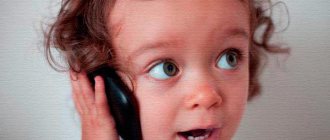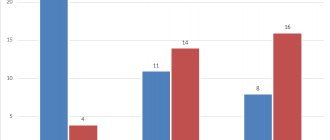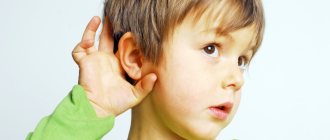Card of primary speech examination
Students enter Type VIII correctional school throughout the entire academic year.
Speech therapy groups are formed in September, but the speech therapist conducts a speech examination of all newly admitted children and determines the type of speech therapy assistance if the child needs it.
At this stage, I suggest using a primary speech examination card (a mini-version of a speech card), and when enrolling in speech therapy classes, fill out the generally accepted detailed speech card.
The card contains general information about the child, then an initial speech examination is carried out.
The overall sound of speech includes speech intelligibility, tempo, fluency, and voice strength characteristics.
The structure and mobility of the organs of articulation: deviations from the norm in the structure and the volume of articulatory movements are recorded.
Speech comprehension research includes: understanding instructions; understanding contextual speech; understanding of the simplest questions and questions of indirect cases; understanding prepositions; understanding of logical and grammatical structures.
Sound pronunciation state: the child pronounces a particular sound using pictures.
The study of syllabic structure is carried out using pictures, the names of which reflect different syllable complexity. Perseverations, eliminations, rearrangements, additions of sounds and syllables are recorded.
Vocabulary research is carried out in the form of a survey based on pictures. It is necessary to present both rarely occurring and frequently occurring words. Knowledge of generalization words is checked, the volume of parts of speech in the student’s dictionary is established.
The study of the grammatical system includes: the use of prepositions, changing words by case, various types of word formation, coordination of various parts of speech.
Studies of coherent speech: the student is asked to compose a story based on a series of plot pictures, based on a plot picture, and retell the text told by a speech therapist.
Study of written speech: the child’s workbooks are examined, the written short dictation is checked, and a text is offered for reading. During the examination, the presence of specific errors is revealed
The “Recommendations” column indicates whether the student needs speech therapy assistance, recommended types of classes, whether he is enrolled in classes or put on a waiting list.
Vostrokh Olga Vladimirovna, teacher-speech therapist MKS(K)OU "S(K)OSH No. 58", Kemerovo region, Novokuznetsk
- Speech card and presentation for examination of a 6-7 year old child
- Speech card for examination of a preschool child
- Characteristics of the teacher for the child (for examination at the PHC Consultation)
- Presentation “Technology for organizing speech therapy examinations in preschool educational institutions”
- Speech card for school speech center
( 1 liked, average score: 5.00 out of 5)
Loading...
Journal of speech therapy examination
It is convenient to keep a journal of speech therapy examination in the form given on p. 83. The magazine itself is made from a thick notebook that unfolds horizontally. The speech therapist can also record the examination results in a regular class journal for school teachers.
It is recommended to leave free space in case new children join the group. In such a log, the state of speech in dynamics is clearly visible.
When examining young children, the speech therapist must note the general level of speech development (normal, developmental speech development, dysarthria, features of the anatomical structure of the organs of articulation). When working with middle-aged children, it is necessary to describe in detail the state of sound pronunciation, features of lexical and grammatical development and coherent speech. This will help identify children who need to be transferred to a specialized preschool institution and identify children for enrollment in a speech center. The examination of children of senior preschool age is carried out in a similar way.
The advantage of this journal is that there is no need to annually rewrite the names of all children in the group.
In the notes, the speech therapist makes notes about the child’s transfer to another institution, indicates the date of enrollment or graduation from the speech center, and the number of the protocol in which the fact of enrollment (graduation) is recorded.
Logopunkt GOU d/s No. ________
____________________________
JOURNAL OF SPEECH PEDIC EXAMINATION OF CHILDREN
group no. _________
| No. | Last name, first name of the child | Child's date of birth | 20_ - 20_g Speech development. Recommendations | 20_ - 20_g Speech development. Recommendations | 20_ - 20_g Speech development. Recommendations | Note |
| 1 | ||||||
| 2 | ||||||
| 3 | ||||||
| 4 | ||||||
| 5 | ||||||
| 6 | ||||||
| 7 | ||||||
| 8 | ||||||
| 9 | ||||||
| 10 |
Speech card
For each child enrolled in a speech center, a speech card is created, in which the features of the phonetic side of the child’s speech are recorded (the general sound of speech, the state of phonemic hearing, features of sound pronunciation); state of lexical-grammatical structure and coherent speech.
Speech card of a child who underwent examination[14]
Last name, first name of the child ______________
_________________________________
Date of Birth
________________
Group __________
___________________
General speech sound (normal, pronunciation of sounds is blurred, weakly labilized) _________________________
______________________
Voice (normal, hoarse, nasal) _________________________
Tempo (normal, bradyllalia, tachylalia) ___________________________________
Smoothness (hesitation, stuttering) ___________________________________
Strength (normal, strong, weak, fading) ______________________
Structure of the speech apparatus:
Lips (normal, thick, thin, everted) _______________________
Teeth (edentulous, normal) __________________________________________
Sky (normal, high) ________________________________________
Occlusion (normal, progenia, prognathia, open) ___________________
Tongue (normal, thick, thin, small, massive, geographical, forked) __________________________________________________________
Bridle (normal, shortened, short) __________________________
Salivation (normal, increased) ____________________________
Phonemic hearing (normal, slightly impaired, severely impaired)
__________________________________________________________________
RA-LA-RA ____________ SHA-SHA-SA ___________
SA-ZA-ZA ____________ BA-PA-BA _____________
TA-DA-TA ____________ DE-DE-DE _____________
KA-GA-KA ____________ TE-DE-TE _____________
VE-FE-FE ____________ LE-VE-LE _____________
A hat and a fur coat - that’s the whole bear ____________________________
______________________________________________________________ Osa is barefoot and without a belt ___________________________________________
_____________________________________________________________
The watchmaker narrowed his eye, fixing the watch for us ____________________
_____________________________________________________________
Our Dasha loves drying, drying is not porridge for you __________________
_____________________________________________________________
Lara has a red balloon and a blue scarf ____________________________
_____________________________________________________________
Vowel highlighting:
| at the beginning of a word | at the end of a word | in the middle of a word | ||||||
| Alik | duck | Olya | balls | moon | milk | onion | varnish | juice |
Syllable structure (broken)
______________________________________
Children released birds from cages _________________________________
_____________________________________________________________
Leaves fell off the sea buckthorn branches ___________________________
_____________________________________________________________
There are a lot of perishable foods in the refrigerator ________________
_____________________________________________________________
Policeman Valery regulates traffic _____________
_____________________________________________________________
Policeman __________ Construction ___________
Shipwreck ______ Button _______________
Aquarium _____________ Excavator ______________
Grammatical structure of speech
| Noun units | Noun pl. h. | R. p. pl. h. | R. p. unit | Use prepositions | ||||
| Table | IN | Behind | ||||||
| Window | On | U | ||||||
| Forehead | Under | Above | ||||||
| Ear | TO | From | ||||||
| Chair | Between | Near | ||||||
| Bag | Because of | From under | ||||||
| Bucket | ||||||||
Word formation
| Nouns with a diminutive meaning | Antonyms | ||
| Door | Soft | ||
| Nest | Far | ||
| River | Old | ||
| Iron | Spicy | ||
| Finger | Narrow | ||
| Relative adjectives | Possessives adjectives | ||
| Wooden chair | Fox nose. Whose? | ||
| Glass glass | Dog ear. Whose? | ||
| Leather bag | Bear paw. Whose? | ||
| Brick house | Mom's coat. Whose? | ||
| Paper bag | Dad's boots. Whose? | ||
Connected speech:
Retelling (S, V, N[15]) ____________________________________________
_____________________________________________________________
_____________________________________________________________
_____________________________________________________________
_____________________________________________________________
_____________________________________________________________
A story based on a series of plot paintings (C, V, H) _______________________
_____________________________________________________________
_____________________________________________________________
_____________________________________________________________
_____________________________________________________________
Story based on the picture (C, V, N) _____________________________________
_____________________________________________________________
_____________________________________________________________
_____________________________________________________________
_____________________________________________________________
Formation of the leading hand (lateralities) ________________________
_____________________________________________________________
Pronunciation state
Absence ___________________________________________________
Replacement _______________________________________________________
Distortion (m/z, uvular) _____________________________________
Text for the survey: A fluffy white hare jumped out from under a gooseberry bush. He squinted into the sun and buried himself in a deep hole under a spruce tree.
| WITH | Sue | Z | 3 | C | Sh | AND | H | SCH | L | l | R | Ry | G | TO | X | Y |
Speech diagnosis at the beginning of work
_____________________________________
____________________________________________________________________________________________________________________________________
Final diagnosis
____________________________________________
____________________________________________________________________________________________________________________________________Recommendations
______________________________________________________
____________________________________________________________________________________________________________________________________
"____" ___________ 200____
Speech therapist__
_________________
Document retention periods
As noted above, the mandatory documentation that makes up the financial statements must be stored in the speech therapy center for a certain time. For example, a log of attendance at speech therapy classes; speech cards of students enrolled in speech therapy classes, with accompanying notebooks for testing; annual reports on the work done should be kept until all students included in these documents are completely released from the speech therapy center, that is, 3 years.
It is advisable to keep a log of students’ oral and written speech and a list of students with speech disorders in a speech therapy center until all students included in the log and list leave school, that is, for 10 years. This is explained by the fact that these documents contain information about all students examined and identified by the speech therapist teacher, indicating the measures taken regarding them and the results of correctional work.
The speech therapy office's passport is located and stored in the office permanently.
There are no strict retention periods for other types of documentation.






